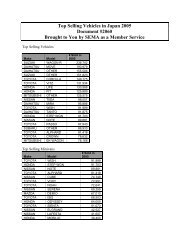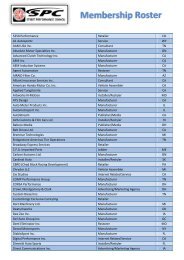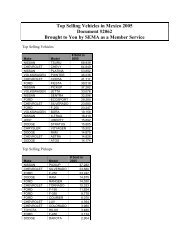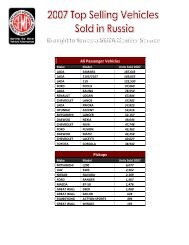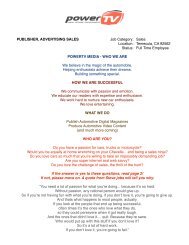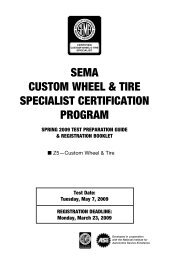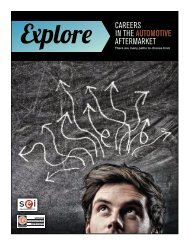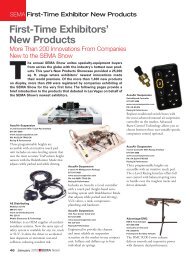Show Daily - Sema
Show Daily - Sema
Show Daily - Sema
Create successful ePaper yourself
Turn your PDF publications into a flip-book with our unique Google optimized e-Paper software.
Pinstriping and<br />
Lettering: The Lost Art,<br />
Continued from page 51<br />
all my work when I’m finished with the<br />
project. This is not uncommon, as most<br />
of the time you’ll see a signature of some<br />
kind on handpainted art. The reason is<br />
because artists are proud of their work,<br />
and that includes me.<br />
I started striping in 2006. I was at a<br />
friend’s tattoo shop, and I noticed on<br />
the back of an airbrush magazine he<br />
was reading a how-to step-by-step pinstriping<br />
panel. I told my buddy that I<br />
wanted to try that, and he said, “Yeah,<br />
right! It takes guys years to master that<br />
art form!”<br />
Practice Makes Perfect<br />
I went to the bookstore the very next<br />
day and purchased a selection called<br />
How to Pinstripe by Alan Johnson, a<br />
well-known New Jersey pinstriping<br />
and graphic artist. The first page read<br />
that if you have the will and desire to<br />
pinstripe, buy a gallon of paint and a<br />
brush and when you get to the bottom<br />
of the can, you’ll know how to<br />
stripe. I know that’s a lot of paint,<br />
but I followed his advice and started<br />
practicing for hours on end, day after<br />
day. I would go to bed, get up at 4:00<br />
a.m. and start practicing again just to<br />
52 SEMA <strong>Show</strong> <strong>Daily</strong><br />
stay sharp. It’s like anything else: if you<br />
don’t use it, you lose it. Six months<br />
later, I got good enough that my friend<br />
had enough confidence in me to stripe<br />
his truck.<br />
The practice isn’t all there is to it.<br />
There’s also the research it takes to<br />
become familiar with the products that<br />
are available and figuring out what to<br />
do and what not to do. Experience<br />
plays a big part in it, but, ultimately,<br />
you have to remember that it’s paint<br />
and you will mess up, and that’s the<br />
name of the game. But so what? You<br />
wipe it off and go on.<br />
Products<br />
Let’s talk a little about products,<br />
pricing and overhead. Whether I pinstripe<br />
a car, bike or some kind of<br />
panel art, I use a good wax and grease<br />
remover to clean the surface and follow<br />
that up with Windex. It’s critical to<br />
have a clean surface because that will<br />
make or break you.<br />
As for paint, hardener and reducers,<br />
I use 1 Shot products. A lot of people<br />
will tell you that you can use regular<br />
thinner to thin your paint, and that<br />
may be your preference, but 1 Shot<br />
makes a reducer that works great with<br />
their paint. As added insurance, never<br />
use the thinner or reducer when you<br />
clean your brushes because it could<br />
have oils in it and leave you with<br />
fisheyes in your work. The end result<br />
is you wiping off your work and starting<br />
over. In time, you’ll learn that, as<br />
with anything, practice is the key to<br />
quality pinstriping.<br />
Pricing and Brushes<br />
As for pricing and overhead, you<br />
would be surprised at the reasonable<br />
cost of these products. As for what you<br />
charge, it’s up to you. Everyone isn’t<br />
doing this art form, but everyone wants<br />
it, so do the math.<br />
Brushes are something else to consider.<br />
When I started, I had to have one<br />
of everything out there. And believe<br />
me, everyone has their own brush. I<br />
prefer a Mack 00 Series 20 automotive<br />
touch-up brush, but it’s up to the<br />
individual artist. Again, practicing and<br />
experimentation are key. The 20 Series<br />
will cost you about $9 a piece. Some<br />
guys like the 10 Series, which are made<br />
with different hair and cost twice as<br />
much. Do your research and try some<br />
different ones out there.<br />
Brush care is easy; just clean your<br />
brush with mineral spirits and make<br />
sure you oil them. As for lettering<br />
brushes, do your research and try<br />
what’s out there. Hand lettering is not<br />
for everyone, so I would advise to stick<br />
to pinstriping because that will keep<br />
you busy enough.<br />
The people I try to target as potential<br />
customers are hot rodders, bikers<br />
and tractor trailer drivers. Some<br />
people will do a lot of panel art and<br />
garage art and sell it on eBay. There is<br />
money to be made, but again, research<br />
is key. Canvas your local and outof-town<br />
car shows; the best way to<br />
get your work out there is through<br />
word-of-mouth.<br />
Step by Step<br />
Let’s go through a project step-bystep<br />
to give you an idea of how to<br />
perform this art form.<br />
First, let’s look at the products I<br />
will use:<br />
��Paint thinner (for cleaning brushes<br />
only)<br />
��1-Shot reducer<br />
��1-Shot hardener<br />
��1-Shot lettering enamel,<br />
white-bright red<br />
��Wax and grease remover<br />
(but none for this project because<br />
the panel is clean enough)<br />
��Windex ��Mack 00 20 Series pinstriping brush<br />
��Small lettering quill<br />
Continued on page 54



